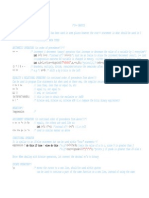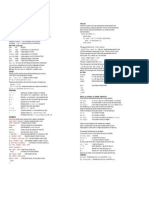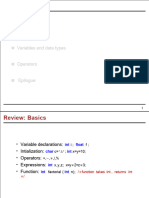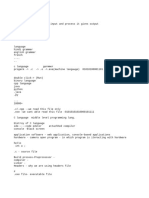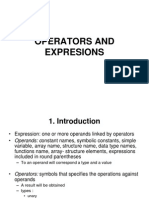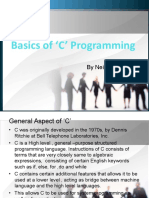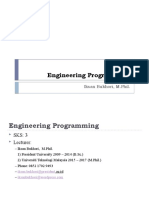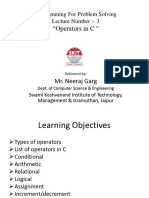0 ratings0% found this document useful (0 votes)
14 views22 pagesC Notes
The document provides an overview of programming concepts in C, including tokens, operators, data types, control statements, loops, functions, structures, and unions. It explains various operators such as arithmetic, relational, logical, and bitwise, along with examples of control structures like loops and conditional statements. Additionally, it covers the use of pointers, arrays, and user-defined functions, emphasizing the importance of data organization and memory management in C programming.
Uploaded by
ayushtechie99Copyright
© © All Rights Reserved
We take content rights seriously. If you suspect this is your content, claim it here.
Available Formats
Download as PDF or read online on Scribd
0 ratings0% found this document useful (0 votes)
14 views22 pagesC Notes
The document provides an overview of programming concepts in C, including tokens, operators, data types, control statements, loops, functions, structures, and unions. It explains various operators such as arithmetic, relational, logical, and bitwise, along with examples of control structures like loops and conditional statements. Additionally, it covers the use of pointers, arrays, and user-defined functions, emphasizing the importance of data organization and memory management in C programming.
Uploaded by
ayushtechie99Copyright
© © All Rights Reserved
We take content rights seriously. If you suspect this is your content, claim it here.
Available Formats
Download as PDF or read online on Scribd
You are on page 1/ 22
PROGRA
MMING IN
C and Cy,
> A token is the smallest element of a program that |(f tic operators are Sed to pee,
is meaningfl in the compiler. Lees ations. Re
‘mathematical oper
pet TMies if Operators ~~
eae ee
1 | Addition, Adds two values
——Sabiraction, Subtracts one vane]
Yfoker} from another
eS
(os) |—— Multiplication, Multiplies ayo
values
[ee ae
(wn) eo ae
another
> Identifier refers to name given to entities such as | |__| reraites divinicas
Variables, functions, structures, array etc. % Remainder is
Identifiers must be unique. rs Increment, increase the value of g
> Keywords is reserved word, It can't use as a variable by |
eS _ ——______
variable name and constant name. Decrement, Decreases the value ofa
auto break case char variable by 1
const | double | else continue
tional Operators
default | do enum | exten =
float for goto if Relational Operators are used to checks the
at ae eT relationship between two operands.
a ae ek | aah Operators | Meaning of Operator
struct | switch | typedef | union Equal to
unsigned | void volatile | while Roce
> Constant is a name given to the variable. It can't z Greater than
altered or changed during execution once < Less than
defined. : >= | Greater than or equal to
D String is a sequence of characters terminated SRM caer ui
with a null character \0' strings are defined as an |__|
array of characters. Example— | Logical Operators — g
Logical operators are used to determine the loge
between variable or values and return either 0 oI
| Operators | Operators Meaning
3 Re ee
Operators are used to perform the operations on && | Logical and, Retums true ifthe both
variables and value. statements are true,
" Logical or, Returns true if the on¢
‘of the statements is true.
t Logical Not, Reverse the result,
Fetus false if the result is true.
Bitwise Operators SAAS
g % — | Percent .
se eperaors are used to perform bit level ie ‘Apostrophe
rat ~
ope = Caret = | Minus si
-ators_| Meaning of Operators mE La
oO Bitwise AND pee |e eae
1 Bitwise OR posit 1, | penis [mee
a : bracket
3 itwise XOR (Exclusive OR) v Left > [closing angle
Z__| Left Shit parenthesis bracket
ss_| Right shin ) | rieht 7 | Question mark
2 Bitwise complement parenthesis
ae = \derscore Left brace
Assignment Operators ; me |e
Assignment operators are used [tue sien_|_ J Risto
are used to assign values :
to variables. Comma i aa aoe
; Period 1_| Right brac
Operators _| Meaning of Operators a te matenraat
= ‘Simple Assignment ~
Multipli * 3 Semicolon
ie 5” pats typed Ia C= There are seveeal dice
Division Assignment ways to store data in C and they are all uniate
%= Remainder Assignment Hon veastitelhcencTi® Floating Point» Union f+ Pointer
z ‘Other Operators |, Double Floating b> Enum Reference
int
Geawtors [Meaning ofOpenos 1) Nea a
SizcoR) | To rerum the actual sizeof Y || 5 Conerol Structure: LOOPS” loop is used to
given variable ; repeat a block of code until the specified
& “To return the address of any given Fcpdition is mst
we ‘Control Statements
* Pointer to @ variable
2: ‘Conditional expression of fenary
operator Selection Iterative
——| Member selection operator Statement | [Statement
operators linked related
2 How for oop works:
>
es
initstatement
For body Loop
Update Expression
/* Calculation of simple interest for 3 sets p,
andr */ r
‘main(){
int p, n, count;
‘float r, si;
for (count = 1; count <=3; count
= count + 1):
Print{("Enter values ofp, n ands");
scanf("%d %d %f", &p, en, dt);
si=p*n*1/100;
Printf("simple interest = Rs. %fin", si);
Symtarnitycondition;inerement){
for
for(init
/jstatement of outer loop
}
t;condition;increment) {
//statement of inside loop
Flow-Chart of Nested for Loop
[outer for loop]
start
[Outer for loop|
—| Test
False
Condition
pia bn
inner for loop
start
as
inner for loop
> test of
False
condition
Block of statement
Update Expression
of inner for loop
Update expression
of outer for loop
e
a
Tos
tee (es
Consider the program Be ton.
ees,
jetatement of
body
Text
Expression
}
Understand operati
Understand operation of the while loop by
input p, n,t
[si = p*n*r/100]
)o/While Loop- This loop will execute the
se block once, before checking if the condition
then it will repeat the loop as long as the |
Syntax
Syntax—
#0,
1. If statement
ifleondition)
{
statement execute if
statement is true
}
if condition
Statement just
below if
2. If-else statement—
if{condition) {
‘Jlexecute block if condition true
jelset
Hexecute if condition false
‘iftest expression) {
“statement
} else if
“statement
}
else iff//statement
2
else {//statement
Statement Syntax— \
‘ispeific condition
break;
1. Breal
Loop body
starts
Condition to ] -,
break from |e
loop
2. Continue statement
Syntax—
Continue;
Condition to
continue next
iteration
xple-
? int main){
int myFirstindext] = ,
printi("%6
return 0;
}
piput = 25
> Array in Loop~
-sample—
int maing)
{
intarr[]= (5, 10, 15, 17,20)
inti=0; ;
while (i<5)
{
Printh("%d", arti);
its
}
return 0;
25, 40, 70,
"70, 150)
* myFirstindex(0), ui
}
wtput = 510 15 1720
Multidimensional Arrays—
A multidimensional array is an array of arrays.
yntax—
data_type array name[sizel ][size2J....[sizeN];
Multi-dimension|
Array
‘Two dimension
Array
hample—
‘Column 0 | Columni | Column 2
Row0| 2 3 4
[Rowt [5 6 8
int main(){
int matrix[2][3] = (1234
{5,6,,8}};
intijs
iH){
for(i=0;j<3; 54)
print"%d\n", matrix
CDs
gage stn
for (i
retum 0;
Outputs
.
2 Strings Strings are
text/characters.
used for storing
Strings Initialize
‘Char of] = "ab"
Char ¢[20) = "ab";
b,10}
Char ef] = {'
Char {6} = ('a'26',
0} Cll] C12)
El fl fo
Oy;
Example—
int main(){
char greetings[] = "Hello YCT";
printf(’%s", greetings);
return 0;
3
Output = Hello YCT
Meniory Address
The memory address is the location of where the
variable is stored on the computers. Memory
address is in hexadecimal form.
Pointers are used.to store the address of variables
or memory location.
‘Syntax—
datatype *var_name;
Declare a pointer variable must be a * before its name.
| How to pointer works
var
pee
int var = I 72008 20 39
Example—
maing(
int a;
irntf("%6d", &a); /iprint address of «
retund;
)
Output = Ox7MS06 7a 104
Note- Output can be assigned different address in
different runs.
Example
int maing(
int® PC, C;
C=32;
Printf{” Address of C:%ed\n", & ¢);
Printf( "value of C:%d\n\n", C);
PC=&C;
Printf(" Address of pointer PC:%d\n"PC);
Printf("Content of pointer PC:%d\n\n", *PC);
c=;
Printf{" Address of pointer PC:%d\n",
Printf{"‘content of pointer PC:%din\
*PC=2;
Printf{"Address of C:%d\n", &C);
Printf("value of C: %d\n\n", C);
return 0; ;
3
PC);
* PO);
‘Output
Address of C : 0x7£%448586Sec
Value of C: 32
Address of pointer PC: Ox7#fd485P55ec
‘Content of pointer PC: 32
Address of pointer PC: Ox7fid485t65ec
‘Content of pointer PC: 11
Address of C: 0x7114485f65ec
Value of C: 2
BE oneness
Funetions- A function is a block of code which
only runs when itis called,
Syntax—
void myFunct() { declaration
“code to be executed( definition)
3
Library Functions 1
© Standart, defined in header Biles me
_—* SS
Tis ope of console cuiparis
ioh | It is type of onsoe Cup
conto | fit ee ow
| It is a standard type of outputin
wtdion | Itis OF out atap
: Gh Ls)
ei The function are react
a ‘operations, i
1 The functio lated to err
fh | The funi jon are related 10 eran
om | functions tay
| print) | The function send formatted
Fe | seven. This tmnetionstotnnd in the ag
header file. ,
Copel | Character type functions
asserth | Program assertion functions
User defined funetion— Working flow gr
defined function
#include
void functionName(){
ee
int main(){
fanctionName();
[asd ;
}
function names are identifiers and shoud
: ®
unique.
User Defined Funetion
1. No arguments and no return value
2. No arguments and a retum value
3. Arguments and return value
4. Arguments and with retum value
1.No Arguments an
Syntax-
Void function name(){
dino return
'd no return value—
q
wens and No return value
© 17d function_name(typel argument,
{ype? angument2,...typeN argumentN)
execute program
retum;
)
gaments and with return value“
Po
retur_fype function_name(typel ‘arguments1,
type2 arguments2___typeN arguement)
{
WVexecute program
return value; Y
(ebRecursion = [QS
A fiction tat calls itself is known as a
recursive function and technique is known as a
recursioh. This technique provides a way to
break complicated problems down into simple
problems which are easier to solve,
© Working of Recursion 8
Recursive
Void recurse() call
}
‘
recurse();
}
int main(),
‘
recurse(); *
; ;
Natural Numbers. >
finclude
intmainQ{ |
int number, reel
return n+ sum(n ~ 1);
else
return n;
} >
Output- Enter a positive integer:6
sum = 21 '
A structure or struct isa collection of variables
(different types) under a single name.
Structure using the struct keyword and
declare each ofits members inside curly braces.
Syntax—
© strugt structureName {
datatype member;
datatype member2;
if
Example
vord {ag or structure
cnn a a
Struct Person {
char name (50];] Members or fields
int CitNo; so of sate
float salary;
h
(9 Symbol Access the structure members.
Example
struct myStructure{
‘int myNum;
char myLetter;
| slanyNums 137i
peas este aoe aan)
BRB ceyworaappeaersiiitie I
We use the typedef keyword to create an alia
ame for data types,
Example
Hinclude
#include
typedef struct person {
char name[S0};
int dtdNo;
float salary;
} person;
int maing{
Person pl;
Strepy(pI.name, "Rahul";
Pl. dtdNo=1010;
Pl.salary = 9000;
Printf("Name; %s\n", p1.name);
Printf(” department No: %din", \pl.dtdNo);
Printf{"salary:%.2f, p1 salary);
return0;
3
Output—
‘Name: Rahul
Department No. 1010
S Salary: 9000
¥ uml comp real =525;
Nested Structure— Nested struct within a struct.
# include
struct complex {
int img;
float real;
B
struct number {
struct complex comp;
int integer;
j num; ba
Poppet mnie | integes 5 Gane taaing
ani campengy
Imaginary Part : 9
Real Part : 5.25
Integer: 6
Structure and Pointers Poin.
members are accessed using arroy
Hinclude
struct Point {
int a, b;
Output-
>
a!
=
Nh
int main(){
struct Point pl = {1,2};
struct Point *p2 = &p1;
print("%4d%d, p2 ra, pa py
return 0;
}
Output: — 1,2
2 Structure and functions 5 ~
passed as function argument like at gga
types. We cam pass individual meni a
structure, and entre structure,
Example—
include
struct student {
char name[40};
int age;
float salary;
8
void display(struct students);
int main({
struct students S1;
printf("Enter name:");
seanf(""6["\n]%*e", SI.name);
rintf{"Enter age: ");
scanfi"%d", &S1 age);
Printf{"Enter salary; ");
seanft"%6t", &SI.salary);
display(S1);
return 0;
ve
ta
a
Enter name: Rahul
Enter age: 29
Enter salary: 9000
Displaying information
Name : Rahul
Age: 29
Salary : 9000
An Array of structures as function
/ arguments An array is a collection of similar
data types. A group of structures of the exact
definition is known as an array of structures,
ple
#include
struct details {
char name [10];
cchar sec [10]
float per;
void print_struct (struct details str_arr{));
int main)
struct details student[3]={
{"Rahul", "A", 90.5},
{"Pramod", "B", 85.5},
{"Vibhav", "C", 98.5},
void print_struct(struct details
str_arr[]) {
inti;
for(i=O; i<3; i++)
printf{"Name:%s\n",
str_arr[iJ.name);
printf("Section:%s\n", str_arrfi]. see);
printf("percentage: % .2fin",stt_art{i.per);
printf("\n");
Union is user defined data type in C, which
Stores a collection of different kinds of the data,
Just like a structure. The keyword union is used
to declare the union in C,
Structure Union
Strut Person ( Usion Person {
chara: /sizeVoyte | ch
Alot bie byte | oa:
} obj: 4 obj:
‘memory
allocation
‘sharing storage equal 10
ee gee T° [os
77 weir object) | YCFRLYCT,
Syte 7 aitanion object)
A byte
Syntax
Union UnionName
{
‘/tmember definitions
h
Example—
#include
include
union course{
char website [50];
char subject [50];
int price;
kK
‘void main() {
union course ¢;
strepy(c.website,"yet.com");
printf("website: Yosin", e.website);
strepy(c.subject, "The ¢ programming
of Language”); a
printf("Book Author: %s\n", ¢.subject);
cprice = I ©
printf("Book Price: %adin", .price)
inta; t
char b;
int main
union test pl;
pl.a=50;
union test*p2 = & pl;
printf("%6d %c", p2—> a, p2 > b)
return 0;
> Object Orichted Programming System—
‘ ors
Class *
Objects
Encapsulation;
Abstraction
Inheritance
Polymorphism ;
Class— A class can be considered a container
“ containing data variables and functions. *
Human Being as a class~ e
Body parts :
Eyes
‘Nose
Functions
D Object Objects are the instances of the class,
When a class is defined, no memory is allocated
but when itis instantiated memory is allocated,
Class person {
‘char name [30];
Sethe ead:
| ‘a
object take UP AEE IM memo,
associated address Tike a rezopg 4 4
structure or union in C. ney
Encaprlation- Keeping the gg.
into single unit ikea capsule," "gy
Consider a real life example of enc "
company, there are different
accounts section, finance section,
etc. The finance section handles aig
transaction and Keeps records of 41 be
related to finance. . Ne
D — Abstraction- It is a process of hin
details from the user.
Abstraction
Data abstraction
Control abstraction
>
1 i
a
Example— ’
#include
using namespace std.;
class implement abstraction {
private:
inta, b;
public;
Void set (int x, inty){
anaes
bey;
} >
void display(){
oUt << "ae" .
using namespace std;
class Yet
public: ‘
© void fun(int x){
cout <<"value of X is”
Example Operator Overloading
Output— count:11
>
In unary operator function no arguments should
be passed. It works only with one class objects.
In binary operator overloading function there
should become argument to be passed.
The operator overloading function must precede
with friend keyword and declare a function class
Scope, friend operator function takes two
Parameter in a binary operator varies are
Parameter in a unary operator
‘include
using namespace std;
class count{
private:
int value;
Public:
count(): value(10) {}
Void operator ++(){
+Hvalue;
}
Void display(){
cout<<"count
< Default ‘Constructor A constr,
Class CLASS_NAME
{
public:
CLASS_NAME(Q)
‘aa
}
//other member functions
i
2 Para-meterized Constructor j, a
parameters in the constructor definijg: “
declaration.
Syntax—
class class Name
4
public:
Class_Name(datatype variable)
feces
}
1
Example-
#include
using namespace std;
class Rectangle{
Private:
double length;
double breadth;
Public:
Rectangle(double I,double b){
length = 1;
breadth
}
double calculateArea() {
return length * breadth;
}
B
int maing
Rectangle objl(10, 5);
Rectangle obj2(13, 8)
‘cout<<"Area of Rectanglel:"
‘<
using namespace std:
class constructor{
Public:
float area;
constructor(){
arca=0;
}
constructor(int a, int b){
area =a*b;
}
void display(){
cout<<"Area:"<
using namespace std;
int count = 0;
class Test{
public:
Test(){
count;
cout<<"\n No. of object created:
\"<
Syntax
template
#include
template
‘Void swapp(swap & i, swap & j){
swap t;
tis
isi
ist
}
int main, '
inte,
char g,r;
float x, y;
‘cout<<""n please irisert 2 integer values”
cin eoe
swapp(e, );
cout<<"\n Integer values after swapping”
couts>p>>r;
‘swapp(g, 1);
cout<<"\n character values after
swapping:";
couts>x>>y,
swapp(x, y);
cout <<"\n the resultant float values after
‘Swapping:";
oUt < Class Template- A class template defines a
family of classes.
Syntax—
template class name;
template
class vector {
TV;
public:
vector(){
v= new T (size];
for(int
J
vector (T* a){
for(int i =0; iy{i] *y.vfij;
return sum;
}
b
int mainO{
int x[3] = {1, 2, 3};
int y[3] = {4, 5, 6};
vector v1;
vector v2;
VIE
v2=yl
intR= vita;
cout<"Ra"<
#include
using namespace std;
template
void display (T'x){
cout<<"Template
}
void display(int x) {
cout <<"Explicit display:"< Cateh(—exception_deelaration —) —
(statement —j-»~
2 Throw expressions You use a throw
expression to indicate that your program has
‘encountered an exception.
Syntax—
a miei ea
assignment_expression
the type of assignment_expression can't be an
incomplete type, abstract class type, or a pointer
to an incomplete type other than the following
types. ‘
void®
const void *
volatile void *
const volatile void *
The catch block that catches an exception must
immediately follow the try block that throws the }
extéption. The general form of these two blocks
are
throw exception; /block of statements
— which detects and
— throws an exception
}
Catch (type arg) {
---~ //block of statements that
-- handles the exception
‘cout<<"\n we are inside the function\n"s
if(x-y)!=0){
int R= 20-9);
cout<<"Result+"<
using namespace std;
void divide(double x, double y){
cout<<"inside function\n";
try
ifly==0.0)
throw y;
else
COUt<<"Division="<> and << ;- We have
used the objects cin and cout (pre defined in the
‘ostream file) for the input and output of data of
various types.
jin>>variable|>> variable2>>....>variabl
This is the general format for reading data fom
the keyword.
arian ae ctr el ™
Ne
and put() respectively to handle the single See te coarse:
character inpuvoutput operations. using namespace std;
0) int main
int size = 20;
char city(20];
get(char*) get(void)
Bet(char*) version assigns the input character to
its argument
fetums the input character.
#include
using namespace std;
-<"Bnter City Name:\n";
cou
cin>>city;
cout<"City name," <
finclude
\ing namespace std;
‘/user defined manipulators
stream & currency (ostream & output) {
Output <<"Rs";
‘return output;
that define the file handling methods,
Class
Contents
filebuf
Its purpose is to set the file buffers
to read and write, Contains
‘openprot constant used in the
open() of file stream classes. Also
contain close() and open() as
members.
fstreambase
Provides operations common to the
file stream. Serves as a base for
ifstream
ofstream
Provides input operations.
Contains open() with default input
mode, Inherits the functions get),
ind tellg0
getline(), read() seeke(
tions from istream.
Provides output operations.
Constains open() with default
output mode, Inherits put,
seekp(), tellp() and ~—wrtie(),
function from ostream,
Provides support for simultaneous
input and output operations.
Contains open() with default input
made. Inherits all the functions
from istream and ostream classes
through iostream,
Opening and Closing a file
The first method is usefull when we use only one
file in the stream. The second method is used
when we want to manage multiple files using one
stream.
Opening and closing a file
“Using the constructor
function of the class
‘Using the member
function open() ofthe class,
Opening files using constructor
We know that a constructor is used to initialize
an object while it is being created.
Create a file stream object to manage
the stream using the appropriate class, That is to
say, the class ofstream is used to create the
‘output stream and the class ifstream to create the
input stream.
Initialize the file object with the
desired filename.
ffstream infile("data")://input only
Example~
#include
include
cout<"Enter ifem name:
char name[30];
ein>>names
outf>> names
outfe> cost;
outfe>name;
in>>cost;
cout<<"\n";
cout<<"item name": <
#include
int main {
ofstream fout;
fout.open("Country");
fout<<"United States of America\n";
fout<<"United Kindom\n";
fout<<"south Korea\n"
fout.close();
fout.open("Capital");
fout<<"Washinton\n";
fout<
You might also like
- Programming For Engineers: Chapter 2 Introduc7on To C ProgramsNo ratings yetProgramming For Engineers: Chapter 2 Introduc7on To C Programs38 pages
- C Language: Step 1: Creating A Source CodeNo ratings yetC Language: Step 1: Creating A Source Code14 pages
- Programming and Data Structures (PDS) : CS11001/CS11002No ratings yetProgramming and Data Structures (PDS) : CS11001/CS1100212 pages
- CP-EXAMEN!!!!: Algorithm, Given Both The Problem and The Device: Precise Characterization of ANo ratings yetCP-EXAMEN!!!!: Algorithm, Given Both The Problem and The Device: Precise Characterization of A11 pages
- Data Types & Basic Constructs (If, If-Else, Switch-Case)No ratings yetData Types & Basic Constructs (If, If-Else, Switch-Case)16 pages
- CSC 218 Lecture Slides (Intro To C++) - 1No ratings yetCSC 218 Lecture Slides (Intro To C++) - 143 pages
- Engineering Programming: Iksan Bukhori, M.PhilNo ratings yetEngineering Programming: Iksan Bukhori, M.Phil29 pages
- I N F I X: Operator Description Example AssociationNo ratings yetI N F I X: Operator Description Example Association3 pages
- Chapter4 Fundamentals of C 230806 082534No ratings yetChapter4 Fundamentals of C 230806 08253434 pages







